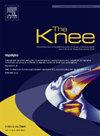Outcomes of two-stage total knee arthroplasty following septic arthritis of the native knee: A propensity score-matched analysis
IF 2
4区 医学
Q3 ORTHOPEDICS
引用次数: 0
Abstract
Aim
To compare the functional outcomes and complications between two-stage total knee arthroplasty (TKA) performed in patients with native knee joint infection and TKA performed in patients with osteoarthritis (OA).
Methods
This was a retrospective study of 25 patients (25 knees, septic arthritis group) who underwent two-stage TKA for septic arthritis of the native knee joint between 2013 and 2021. Through 1:3 propensity score matching for age, sex, body mass index, follow up duration, and American Society of Anesthesiologists (ASA) score, 75 cases of TKA performed for OA (OA group) were included in the control group. Radiological and functional outcomes and complication rates were compared between the two groups.
Results
There was no significant difference in radiological outcomes between the two groups. Preoperative range of motion (ROM) (72.8 ± 23.8 vs. 128.0 ± 7.2, P < 0.001) and all preoperative patient-reported outcomes (P < 0.05) in the septic arthritis group were inferior compared with the OA group. The postoperative ROM (112.0 ± 15.7 vs. 132.3 ± 7.3, P < 0.001) and patient-reported outcomes (all parameters, P < 0.05) were also inferior in the septic arthritis group. The incidence of periprosthetic joint infection (three cases vs. none, P = 0.014) and the reoperation rate (four cases vs. one case, P = 0.013) were significantly higher in the septic arthritis group.
Conclusions
Two-stage TKA for septic arthritis of the native knee joint showed relatively good infection control and functional outcomes. However, it was associated with a higher risk of periprosthetic joint infection and poorer functional outcomes compared with TKA performed for OA.
脓毒性膝关节炎后两期全膝关节置换术的结果:倾向评分匹配分析
目的比较膝关节感染患者行两期全膝关节置换术(TKA)与骨关节炎(OA)患者行全膝关节置换术(TKA)的功能结局和并发症。方法回顾性研究2013年至2021年25例(25个膝关节,化脓性关节炎组)膝关节化脓性关节炎患者进行两期全膝关节置换术。通过年龄、性别、体重指数、随访时间及美国麻醉学会(ASA)评分的1:3倾向评分匹配,将OA行TKA患者75例(OA组)纳入对照组。比较两组患者的影像学和功能预后及并发症发生率。结果两组患者放射学预后无显著差异。化脓性关节炎组术前活动度(ROM)(72.8±23.8 vs 128.0±7.2,P < 0.001)和所有术前患者报告的结果(P < 0.05)均低于OA组。脓毒性关节炎组的术后ROM(112.0±15.7 vs 132.3±7.3,P < 0.001)和患者报告的结果(所有参数,P < 0.05)也较差。脓毒性关节炎组假体周围关节感染发生率(3例对1例,P = 0.014)和再手术率(4例对1例,P = 0.013)明显高于脓毒性关节炎组。结论两期全膝关节置换术治疗脓毒性膝关节炎具有较好的感染控制和功能预后。然而,与骨性关节炎的TKA相比,它与假体周围关节感染的风险更高,功能结果更差。
本文章由计算机程序翻译,如有差异,请以英文原文为准。
求助全文
约1分钟内获得全文
求助全文
来源期刊

Knee
医学-外科
CiteScore
3.80
自引率
5.30%
发文量
171
审稿时长
6 months
期刊介绍:
The Knee is an international journal publishing studies on the clinical treatment and fundamental biomechanical characteristics of this joint. The aim of the journal is to provide a vehicle relevant to surgeons, biomedical engineers, imaging specialists, materials scientists, rehabilitation personnel and all those with an interest in the knee.
The topics covered include, but are not limited to:
• Anatomy, physiology, morphology and biochemistry;
• Biomechanical studies;
• Advances in the development of prosthetic, orthotic and augmentation devices;
• Imaging and diagnostic techniques;
• Pathology;
• Trauma;
• Surgery;
• Rehabilitation.
 求助内容:
求助内容: 应助结果提醒方式:
应助结果提醒方式:


